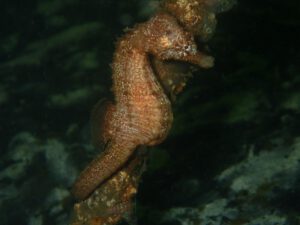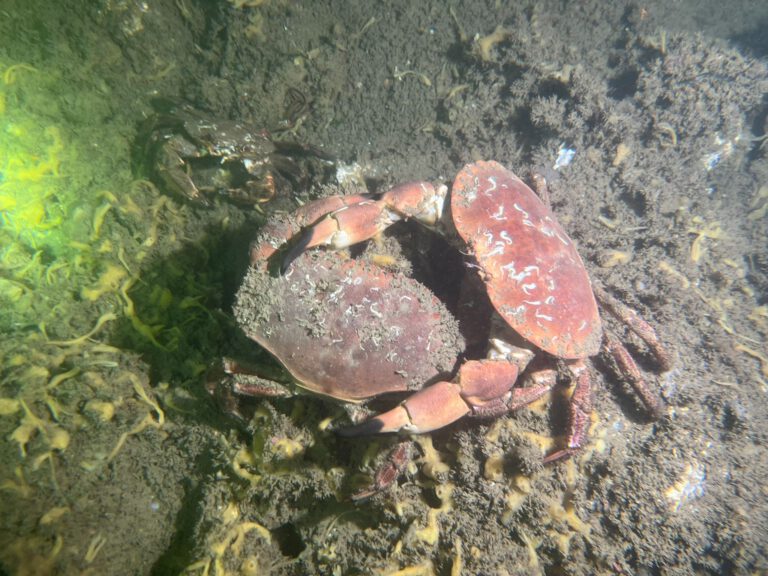Seahorse (Hippocampus) – Zeepaardje

Seahorse (Hippocampus) - Zeepaardje
- Taxonomy: The Seahorse belongs to the *Syngnathidae* family, which includes pipefish and seadragons. Their name means “fused jaws,” referring to their tube-like snouts.
- Species: Over 40 recognized species, ranging from 1.5 cm (dwarf seahorse) to 35 cm (big-bellied seahorse).
- Reproduction: Males carry and give birth to the young; pregnancy lasts 10 days to 6 weeks, depending on species and temperature.
- Habitat: Found in coastal waters globally, typically in shallow areas like coral reefs, seagrass beds, and mangroves.
- Diet: Carnivorous, feeding on small crustaceans like plankton and shrimp. They lack teeth and a stomach, requiring frequent feeding.
- Conservation: Threatened by overfishing, habitat loss, and pollution; some species are protected under international agreements like CITES.
- Unique Anatomy: Upright swimmers with prehensile tails; can move eyes independently.
- Color Change: Capable of changing color for camouflage, aiding in protection and environmental adaptation.
- Lifespan: Typically 1 to 5 years in the wild, depending on the species.
Seahorses: Mystical Dwellers of the Sea
When you think of the ocean, images of majestic whales, colorful coral reefs, and swift sharks likely come to mind first. But the sea also hosts a number of mysterious and graceful creatures that are often overlooked, like seahorses. These enchanting animals are not only unique in appearance but also in their behavior and role in the ecosystem.
What is a Seahorse?
Seahorses belong to the genus *Hippocampus*, which means “horse-sea monster” in Greek—a fitting name given their horse-like heads and elegant, curved necks. Seahorses are small, upright fish commonly found in shallow tropical and temperate waters. Where they anchor themselves to seagrass or coral with their prehensile tails.
One of the most striking features of seahorses is their ability to change color to blend in with their surroundings, a trait that helps them survive in the wild. Their bodies are not covered with typical fish scales; instead, seahorses have skin stretched over a series of bony plates.
A Day in the Life of a Seahorse
Seahorses are not strong swimmers, relying on their dorsal fin, which flutters rapidly. To propel them through the water. Despite their cute appearance, seahorses are predators, hunting small crustaceans like plankton and tiny shrimp. They use their tube-like snouts to suck up their prey, which is one reason they lack teeth and a stomach; they need to eat almost constantly to survive.
Unique Reproduction: A Reversed Role
What truly sets seahorses apart is their unique reproductive system. In most animal species, the female carries the eggs, but in seahorses, it’s the other way around. The female deposits her eggs into a special pouch on the male’s abdomen, where he fertilizes and carries them until they are ready to hatch. After a few weeks of pregnancy, depending on the species and water temperature, the male “gives birth” to hundreds of tiny seahorses, which are immediately independent and must fend for themselves.
This reversed role in reproduction is extremely rare in the animal kingdom and makes the breeding process of seahorses one of the most fascinating behaviors in nature.
Ecological Role: Guardians of Seagrass
Although small, seahorses play a crucial role in their ecosystems. They help keep populations of small crustaceans in check, which indirectly supports the health of seagrass beds and coral reefs. Seagrass beds are important nurseries for many fish species, and by maintaining these areas, seahorses contribute to the overall biodiversity of the ocean.
Unfortunately, seahorses are threatened by habitat loss, pollution, and illegal trade for use in traditional medicine and aquariums. This has led to many species now being considered vulnerable or endangered.
Conclusion
Seahorses are undoubtedly some of the unique and enchanting dwellers of the sea. With their distinctive appearance, fascinating reproductive behavior, and significant role in the ecosystem. They deserve our admiration and protection. So, the next time you look out at the ocean, take a moment to think of these small but incredibly special creatures that call the sea their home.







